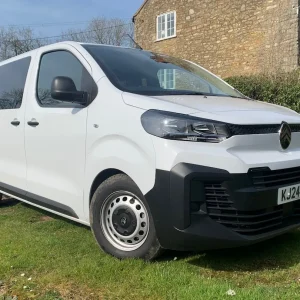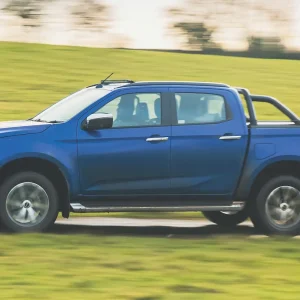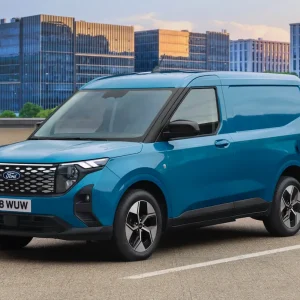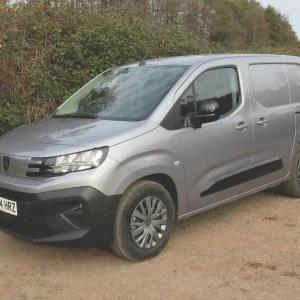Several manufacturers now offer light commercials with this sort of configuration. Well to the fore is Ford, with the Double Cab-in-Van version of its iconic Transit. We decided to sample one to see if it is as versatile as the manufacturer claims.
Technical
 We opted for a five-seater medium-wheelbase, medium-roof front-wheel drive 280 in Limited trim powered by the 140hp version of the 2.2-litre Duratorq TDCi common rail diesel. Maximum power kicks in at 3,500rpm while peak torque of 350Nm makes its presence felt across a 1,800rpm – 2,400rpm plateau. The four-cylinder 16-valve turbocharged and intercooled engine is married to a manual six-speed gearbox.
We opted for a five-seater medium-wheelbase, medium-roof front-wheel drive 280 in Limited trim powered by the 140hp version of the 2.2-litre Duratorq TDCi common rail diesel. Maximum power kicks in at 3,500rpm while peak torque of 350Nm makes its presence felt across a 1,800rpm – 2,400rpm plateau. The four-cylinder 16-valve turbocharged and intercooled engine is married to a manual six-speed gearbox.
Goodness knows why, but our vehicle was fitted with an optional cold starting pack capable of firing up the engine at -29°C for an extra £125; all prices quoted here exclude VAT. Maybe somebody at Ford is expecting global freezing rather than warming.
Independent suspension with MacPherson struts plus an anti-roll bar is fitted at the front while leaf springs help to support the back. Its Limited trim meant that our demonstrator rode on 16in alloy wheels, shod in this case with Hankook Radial RA14 205/65 R16C tyres for a further £400.
ABS comes as standard, with disc brakes all round, as does Electronic Stability Programme. Power-assisted steering offers an 11.9m kerb-to-kerb turning circle, increasing to 12.5m wall-to-wall.
Grossing at 2.8 tonnes, our test Transit could cope with an 878kg payload and tow a trailer with an all-up weight of 700kg. You can order 85hp and 115hp versions of the 2.2-litre if 140hp is more than is necessary.
Load Area
 Separated from the second row of seats by a full height plastic bulkhead with a tinted window, the cargo area offers a useful 6.0m3 of carrying space. Maximum length is 1,893mm, maximum width is 1,762mm narrowing to 1,390mm between the wheel boxes, while maximum height is 1,745mm.
Separated from the second row of seats by a full height plastic bulkhead with a tinted window, the cargo area offers a useful 6.0m3 of carrying space. Maximum length is 1,893mm, maximum width is 1,762mm narrowing to 1,390mm between the wheel boxes, while maximum height is 1,745mm.
Rear loading height is 535mm while the rear door aperture is 1,666mm high and 1,540mm wide. In our case the twin, unglazed, back doors could be swung through 256° for an additional £280 once the stays that hold them at 90° were released.
The doors and sides of our Transit’s cargo bay were clad with protective panels to around one-third of their height and the wheel boxes were encased in protective plastic shrouds. A tailored rubber mat was fitted too as part of the Limited deal.
Loads could be restrained through the judicious use of half-a-dozen tie-down points, including one above each wheel box. The additional 12v power point in the back costs £10.
Cab Comfort
 With vast amounts of storage space for all the bits and pieces drivers have to carry around with them, there’s no denying that Transit’s dashboard is one of the best designed in the business. Three lidded compartments, one of which features a 12v power point — there is another power point in the middle of the facia — are set into the top. The centre one’s lid can be flipped over and turned into a meal tray, complete with a couple of cup-holders.
With vast amounts of storage space for all the bits and pieces drivers have to carry around with them, there’s no denying that Transit’s dashboard is one of the best designed in the business. Three lidded compartments, one of which features a 12v power point — there is another power point in the middle of the facia — are set into the top. The centre one’s lid can be flipped over and turned into a meal tray, complete with a couple of cup-holders.
At each extremity of the dash you’ll find a big bottle-holder plus a cup-holder. A roomy, lidded, but not lockable glovebox is provided plus another, smaller, lidded compartment just below the heating and ventilation controls. Each of the front doors boasts a roomy bin divided into two sections and there’s a storage area above the cab that’s accessible from the back seats.
Air conditioning is fitted to Limited Transits along with electric windows and big, electrically adjustable, heated exterior mirrors with a separate wide-angle section. Our demonstrator boasted an MP3-compatible radio/CD player — we like the big, chunky, easy-to-use switches with remote controls on a stalk on the steering column — in a package that included satellite navigation for an extra £945.
It also boasted an excellent driving position with a height-adjustable heated seat with an inflatable lumbar support. A driver’s airbag comes as standard and our test vehicle had been equipped with a front passenger airbag and side airbags along with a multi-adjustable single front passenger seat; the entire front seat pack costs £300.
Other features include a trip computer and Bluetooth wireless connectivity. Light commercial owners looking forward to the usual miserable British winter might care to note that our Transit was equipped with a heated windscreen; no more screen-scraping on frosty mornings.
Stainless steel steps in the front bumper make it easy to climb up and clean the glass whatever the weather. But don’t accidentally kick the fog lights while you’re doing so.
Good to see that each of the passenger saloon’s three comfortable rear seats comes with a headrest and a lap-and-diagonal belt — the middle seat in such vehicles sometimes has no headrest and only a lap-strap to keep the occupant in place — and that they offer more legroom than one might expect. Nor is there any lack of head or shoulder room. Access to the back seats is by means of a sliding door on each side of the body if you pay a further £300.
The gearstick is mounted on a moulding that projects from the centre of the dash, obstructing cross-cab movement. Nor were we entirely happy with the quality of some of the materials used in the cab, with the fit and finish of the facia — we’re particularly thinking about the lids of some of the compartments — giving cause for concern.
On the Road
 With plenty of power on tap, this Transit flies along. It hurtles away from rest, surges up hills without drawing breath and has to be kept firmly in check at motorway speeds. Fortunately it’s equipped with cruise control.
With plenty of power on tap, this Transit flies along. It hurtles away from rest, surges up hills without drawing breath and has to be kept firmly in check at motorway speeds. Fortunately it’s equipped with cruise control.
When it comes to high speed intercity dashes the sixth gear is a boon and the quality of the gearchange remains one of the best in the business. As for the handling, Transit corners as if on rails — you have to do something really foolish to get it to break away — and the ride is exemplary, even when the vehicle is lightly laden.
Nor do we have any complaints about in-cabin noise levels. One feature we’re not so keen on, however, is the little green arrow — the Shift Indicator Light — that flashes periodically to encourage you to drive more frugally by changing up a gear. Although it’s well intentioned, we found it to be an irritation and feel that it could potentially be a hazardous one. If you keep glancing down to see what the arrow is doing you may be paying insufficient attention to what’s in front of you.
As far as fuel consumption is concerned we averaged 32mpg which in combination with the 80-litre fuel tank gives a range of around 550 miles.
Security is boosted by the need to have the ignition key in order to unlock and release the bonnet. An alarm is fitted along with an immobiliser and our vehicle was equipped with configurable remote central locking for an extra £125. Reversing sensors for an additional £200 should help prevent damage — especially to the attractive metallic paint finish, a no-charge option with this spec — and injury. Side rubbing strips provide some defence against minor scratches and scrapes.
With a service interval of 15,000 miles, Transit Cab-in-Van is protected by a three-year/100,000-mile warranty, including roadside assistance for the entire duration. An eight-year anti-perforation corrosion warranty is provided too.
Verdict
Offering exemplary on-the-road performance, with sharp handling, a slick gearchange and a comfortable ride, Ford’s best-selling Transit is as good as it ever was; if not better. In Cab-in-Van guise it’s extraordinarily versatile, able to fulfil the roles of a family car and a workhorse in a single package. The cab interior is remarkably well designed and everybody gets to travel in comfort. On the downside, the quality of some of the materials used inside the vehicle could be improved, as could the fit of some items; the lids on the dashboard spring immediately to mind. Overall though, Transit remains a hugely impressive package.

 When times are tough everybody needs to save cash. So why run a family car and a van as well when you don’t need to? What you can do instead is get rid of them both and acquire just one vehicle with a second row of seats and a cargo area at the back. That way, you can transport your family about during the evenings and at weekends, and yourself, your tools and your work mates during the week.
When times are tough everybody needs to save cash. So why run a family car and a van as well when you don’t need to? What you can do instead is get rid of them both and acquire just one vehicle with a second row of seats and a cargo area at the back. That way, you can transport your family about during the evenings and at weekends, and yourself, your tools and your work mates during the week.



